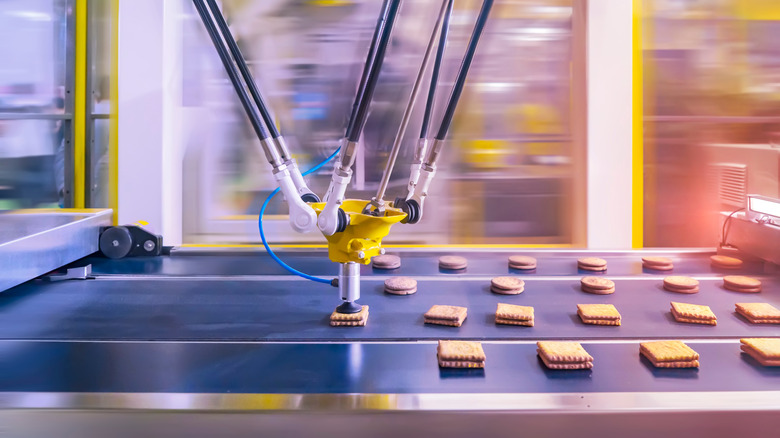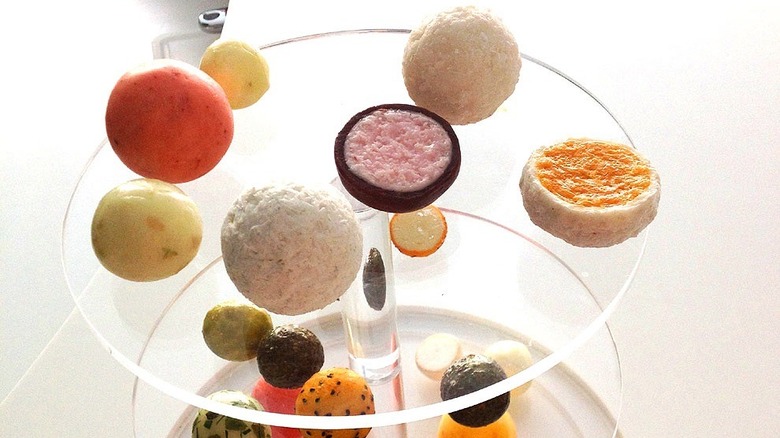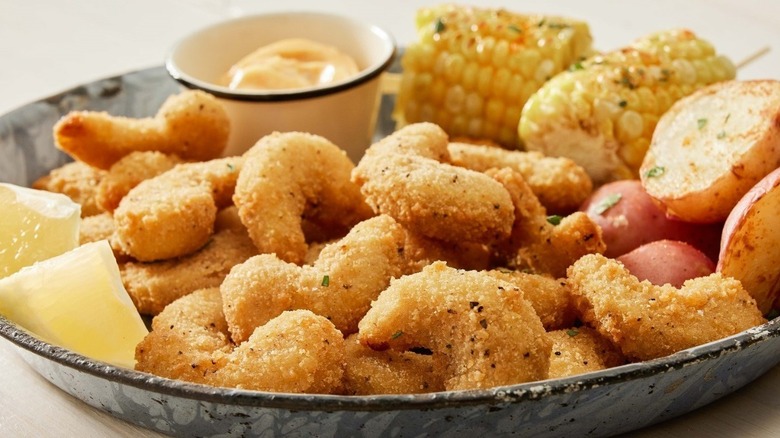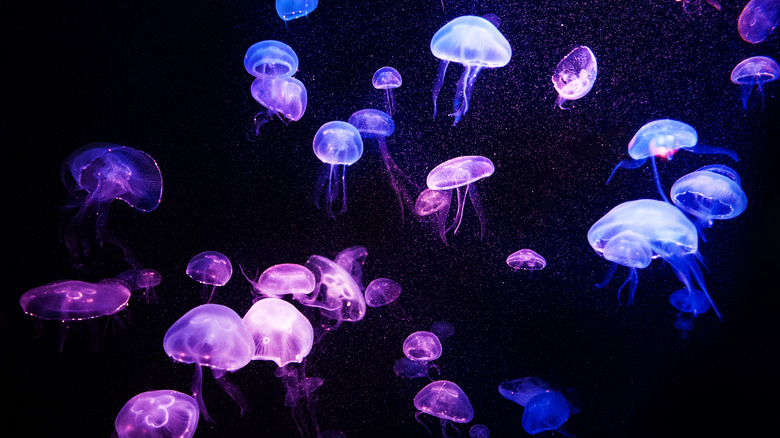High Tech Foods You Can Eat Right Now
Eating is one of the most natural things we do. Yet, it's also one of the most unnatural. Ever since the advent of agriculture and domestication, humans have ceased to eat the way we used to, or the way other animals do. Most of us don't spend our days hunting and gathering to fill our larders. Through selective breeding over thousands of years, genetic engineering in a lab, and processing in a factory, almost everything we eat has been changed or wholly created by technology.
That process remains ongoing. As technology advances, so too do the ways we use it to make food. That might mean new varieties of fruit and vegetables, proteins with better nutrient mixes, or new kinds of desserts. In the hands of the truly creative, or the genuinely unhinged, that can mean culinary creations that are bizarre and incredible. Food engineers are crafting the next generation of gastronomical experiences, inventing new foods and ways to consume old favorites. The foods of the future are here today, and you can eat (or otherwise consume them) right now.
Automatic honey
Traditionally, harvesting honey has meant putting on a beekeeper's suit, opening up your hives, sedating the bees with smoke, removing the frames one at a time, scraping the wax caps off the cells, and collecting the honey. Then the whole process begins again in reverse to put the hive back together. It's a laborious process that isn't pleasant for the beekeepers and isn't pleasant for the bees.
Given our current technological state, surely there's a better way to get our hands on honey without so much trouble. That's the problem Flow set out to solve. Its Flow Hives give your bees a comfortable home to live in and easy access to their honey without disturbing them (via Flow).
Bees enter and exit the hive at their leisure and go about producing wax and honey as they normally would. The front panel of the hive can be partially removed, allowing you to see inside the hive and know when a panel is full of honey and ready to harvest. A valve attached to each panel can be opened and honey collected without the hive being opened up or any of the panels removed. When you're finished, the valve can be closed, and the panel is ready to be filled again. The honey is the same as it ever was, but the hive is pure engineering technology.
Lab-grown meat
Meat makes up a significant portion of many people's diets, but a growing number of people are leaving meat behind. According to Forbes, the number of people who identify as vegan swelled from 1% to 6% between 2014 and 2017. Those numbers are driven in large part not by a distaste for meat, but a discomfort with the way it is acquired.
For years, scientists and entrepreneurs have talked about a future in which we all have access to lab-grown meat made of living tissue samples. Meat grown in a petri dish would provide the same nutrition and dining experience we're used to without grappling with the ethics of our diets. Now, finally, you can try lab-grown meat for yourself, thanks to the California-based food company Eat Just.
The company partnered with a food delivery service in Singapore to distribute lab-grown chicken under the company's GOOD Meat line (via VegNews). It's also available at select stalls and restaurants across Singapore. For those outside of Singapore, you'll have to either wait for the company to expand or make a trip to Southeast Asia. In the meantime, the company also produces Just Egg, a plant-based egg alternative made of mung beans and other plants, available at grocery stores across the United States.
Brave Robot ice cream
If you're not quite ready to try lab-grown meat or mung bean eggs but you still want to try ethically conscious, technologically derived food, Brave Robot might have the perfect thing. For years, if you avoid dairy for ethical or health reasons, the only readily available options — if you had any options at all — were grainy non-dairy ice creams that never really matched up to the real thing. In recent years, the non-dairy alternatives have improved drastically (Ben & Jerry's Non-Dairy P.B. and Cookies, we're looking at you) but what if you could make real milk proteins without involving a cow?
Brave Robot uses microflora like yeast to make milk proteins just the same as you might find in traditional dairy (via Brave Robot). Those proteins are then used to make ice cream that tastes and feels like the real thing. Because the process doesn't use cows or any other milk-bearing animal, it has a lower environmental impact, avoids animal ethics concerns, and doesn't have lactose. So, it's safe for people who are lactose intolerant or who maintain a plant-based lifestyle. It's available at grocery stores all over the country, in flavors like chocolate chip cookie dough, raspberry white truffle, and blueberry pie.
Vaporized alcohol
If you've ever wanted to have a drink without actually drinking, vaporized alcohol might be the high-tech solution for you. In 2015, a notable new bar called Alcoholic Architecture opened in London. According to Wired, the name is a reference to the fact that the entire building acts as a container for a uniquely communal imbibing experience. Once inside the bar, patrons might notice an ambient cloud of mist swirling around them. That mist is alcohol and you're ingesting it simply by hanging out. Sam Bompas, one of the bar's proprietors, told Wired that an hour inside the bar is the equivalent of ingesting a strong drink.
At the time of this writing, Alcoholic Architecture is closed while the owners look for a new location but have plans to reopen in the future (via Bompas & Parr). In the meantime, other companies like Vapshot are picking up the slack with balloons filled with alcohol vapors. As reported by The Drinks Business, these alcohol vapor shots are marketed as a safer way to imbibe but that may not be the case. The effects of inhaling alcohol aren't well understood and, because the alcohol is introduced immediately to the bloodstream, could result in too much consumption too quickly (via Cleveland Clinic). Maybe it's best to stick with an old-fashioned cocktail.
3D-printed food
Gene Roddenberry's "Star Trek" imagines a future for humanity filled with incredible technology and high-flying adventure. Transporters and warp drives often take center stage for their contributions to streamlining travel but when it comes to day-to-day convenience, it's hard to beat the replicators. Here on Earth, we haven't yet mastered 23rd-century technologies — but 3D printers might be the next best thing.
The rise of 3D printing has led to innovations in just about every industry and that includes food. Desserts like chocolate are among the easiest things to print, thanks to the ease of melting and resolidifying, but given a suitable printer, you could combine many different types of foods into personalized cuisine (via GE).
Scientists have experimented with using all kinds of materials to print everything from chicken nuggets to medications, with varying success. In addition to recreating the foods you know and love, one layer at a time, 3D printing also offers unique innovations. Researchers at Osaka University recently created 3D-printed cookies with QR codes which, when scanned, offer useful information like ingredients, nutritional information, and where the cookie came from (via Science Daily). In the future, you might find 3D-printed foods at restaurants or print your own food at home. The only thing stopping you are a few basic ingredients, a 3D printer, and a willingness to mix electronics and liquid chocolate.
WikiPearl edible packaging
Today, nearly every bit of food you buy from a grocery store comes in some kind of packaging. Cans made of steel and tin, cardboard boxes, and plastic bags all keep your food safely separated from the rest of the world. Even fresh fruits and vegetables get tossed in a bag for the short journey from the produce aisle to the checkout counter. WikiFoods hopes to change that with its WikiPearl snacks.
Inspired by nature's packaging, the skins and peels of fruit, WikiFoods produced a desert made of frozen yogurt spheres surrounded by a gel-like edible skin made of fruit, coconut, and extract from seaweed (via NPR). As Treehugger notes, the shell is impervious to air or moisture and according to the company, its pearls can safely sit on a shelf or in a bulk bin without any other packaging. However, NPR notes that when stores started to carry the product, they put them in additional plastic packaging, largely due to customer unease.
Ditching conventional packaging in favor of edible food coverings might be a matter of finding the right environment or the right natural material. Scientists are investigating other possibilities, like using the silk from silkworms to preserve foods in place of plastic (via Science).
Soylent
In 1973, Charlton Heston uttered one of the most remembered lines of his career when he revealed that Soylent Green — the fictional food ostensibly made of plankton — is actually made of people! Forty years later, in 2013, Soylent jumped off the big screen and into the real world in the form of a meal replacement shake instead of nebulously sourced wafers.
In the real world, Soylent is made primarily of soy as well as fats, carbohydrates, and essential nutrients (via Soylent). It's marketed as a complete nutrition meal replacement that offers everything you need to keep your body chugging along. Some folks, including the CEO of the company, have even gone a full 30 days consuming nothing but Soylent, just to see if it can sustain a person. While the sample sizes are admittedly low, and the CEO of Soylent has a considerable bias, these anecdotal tests seem to confirm that Soylent offers everything you need. Josh, over at The Hustle, reported a rollercoaster of emotions and some digestive distress but was able to maintain a rigid fitness regimen for 30 days while consuming nothing but Soylent.
It may not be in your best interest to follow in his footsteps. It's unclear how living on Soylent alone might impact your health long-term, but there's a certain amount of joy that comes from eating that can't be replicated by three shakes a day. They can, however, hold you over in a pinch.
Edible water bottles
According to Grand View Research, billions of disposable plastic water bottles are purchased in the United States every year. Most of those bottles are used only once before being discarded and contribute significantly to global plastic pollution. There are several potential solutions to this problem, including reusable bottles made of more robust materials and improved public water access. Alternatively, you could make your own edible water bottles, keep yourself hydrated, and enjoy a little snack at the same time. As an added bonus, you'll get to do a low-stakes science experiment in your kitchen.
As explained by ThoughtCo., edible water bottles rely on a reaction between water, sodium alginate, and calcium lactate to create a sphere of water trapped inside an edible algae-based barrier. To make your own contained water spheres, you'll need one gram of sodium alginate, five grams of calcium lactate, a couple of bowls, a spoon, and of course some water.
In one bowl, mix the sodium alginate with one cup of water until well incorporated, then let sit for 15 minutes until the mixture becomes clear. Next, mix the calcium lactate with four cups of water. Use your spoon to scoop the sodium alginate mixture and drop it into the calcium lactate mixture. It will immediately form a ball with water trapped inside. Over time, the reaction makes the coating thicker, so experiment with time to find the right water to casing balance.
Seafood from algae
Demand for plant-based proteins is climbing every day, and as the consumer base for vegetarian and vegan meat alternatives grows, many are looking for new ways to eat their old favorites. To date, most of the effort toward engineering fake meats has gone to the classic standbys like burgers and chicken nuggets. In recent years, however, the industry has continued to innovate, crafting meatballs, sausages, and fish patties all made from plant-based ingredients. Even with all of the great options available at grocery stores and restaurants today, plant-based customers remain limited in what they can buy and enjoy. If you found yourself craving some shrimp scampi you were, sadly, out of luck. Until now.
New Wave Foods has stepped in to close that gap with plant-based shrimp, available in three varieties. Consumers can choose between breaded, unbreaded, and Cajun shrimp crafted from seaweed and mung bean protein (via New Wave Foods). New Wave Foods isn't the only one in the game either. As explained by Green Matters, scientists have used a combination of microalgae, soy, and pea protein to make fake shrimp with a convincing taste and texture. Now they're using the same methods to develop plant-based scallops and crab meat.
Jellyfish chips
Jellyfish probably aren't on your weekly shopping list, but maybe they should be. The only problem, or at least the biggest problem, is their rubbery texture. While Jellyfish is already a common food in Asian cultures, it hasn't yet broken into Western markets, but it might have as oceanic ecosystems continue to change. Global climate change is thinning out fish populations, but jellyfish are thriving. As waters warm, swarms of jellyfish are flooding in to fill niches previously occupied by fish species (via Eurekalert). Their abundance has the industry looking hard at how to make them palatable to a wider audience.
Traditionally, jellyfish are picked in a mix of salt and potassium alum for weeks, in order to transform them into something a little crunchier (via Business Insider). A team of Danish scientists developed a method that uses ethanol to achieve the crispy jellyfish transformation in a matter of days, instead of weeks. They presented their findings at a meeting of the Biophysical Society. The end result is a crunchy chip-like snack made of desiccated jellyfish. Yum!
If we can manage to get past our discomfort with eating jellyfish we might discover a new tasty snack, and one that's healthy, too. Jellyfish are made of about 5% protein and the rest of their bodies are water. They are low in calories while being high in B12 and other essential vitamins. And if all else fails you can always sprinkle them with nacho cheese dust.
Bug protein
The unfortunate reality is that the way we produce protein today likely isn't sustainable for the long term. Modern meat acquisition requires overfishing of the world's oceans, continual loss of habitat for grazing sites, and the release of massive amounts of greenhouse gases (via Science Direct). As the global population increases and the strain on the environment grows, we might need to find another way. We might need to eat bugs.
It's something scientists have been thinking about for years and bug-based protein is already a mainstay in some parts of the world. As reported by Time, scientists studying cricket conservation in Madagascar have taken an unusual conservation strategy. In order to save the crickets, they're farming them for people to eat. That's because habitat loss caused by cattle farming was threatening the forests where the crickets live. Maintaining their habitat meant finding an alternative food source. Using their methods, they can produce 31,000 pounds of powdered cricket — enough for roughly 551,000 meals — every year. They're also using the cricket farming facility to train local residents to farm crickets themselves.
As bug protein makes its way into Western cultures, processing crickets and other insects into a flour or meal might be crucial. Crickets can certainly be eaten whole but sprinkling them into your food and disguising them with other tastes and textures might make the whole endeavor a little easier to swallow.











